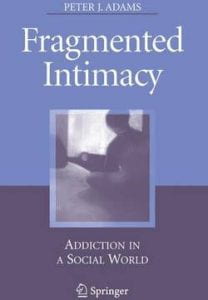A common way of thinking about the ‘self’ is to see it primarily as an individual object and that this object—or particle—is the appropriate focal point for understanding addiction.
Indeed, there are several ways I can view myself as a particle. I am certainly a biological particle: I am made up of bones and muscle, fluids and organs, neural networks and hormonal systems. These are all bound together within a fleshy container; that skin membrane that binds me as a separate organism.
I am also a psychological particle: I experience thoughts and memories, emotions and motivations, attitudes and heartfelt beliefs. These cascade through my consciousness and add together in comprising my inner world; they belong to me and only me and are separate from the psychological events that others may be experiencing.
What both the body-particle (bio-medical) and mind-particle (psychological) interpretations have in common is a thorough commitment to the site of addiction as residing firmly with this autonomous individualized self, this discrete particle.
Accordingly, treatment services have few qualms in focusing most their efforts on people as discrete entities. People commonly travel alone to be assessed at outpatient clinics, they are admitted alone into residential programs, they receive counselling in isolated offices and, where possible, their body-particles are assisted with medications. Very little attempt is made to engage their social contexts; the addiction is firmly located with the individual, not anywhere else.
A growing body of literature in the social sciences have challenged the dominance of understandings which reduce the self to a singular particle. Turning to a social frame involves a radical shift in focus from viewing the self as primarily a discrete particle to viewing it more as an intersection point situated within a complex web of relationships.
To illustrate this, consider the plight of a film crew parachuting into an unfamiliar culture where, through an interpreter, the first question the interviewer is asked is, “Who are you?” This is a tricky question particularly when the two parties have little in common. The interviewer could respond by reflecting on herself as a particle, “Well, physically I’m tall and strong, and good looking … and as a person I am kind and thoughtful and highly motivated in my work…” Her description tapers off as she struggles to think of relevant features. She decides to switch from talking about attributes to describing relationships, “Well, I’m a mother with a two year-old child, my parents live next door, I work on contract for six months per year, I am studying computing at night school…” It is likely her hosts will find the second description of family, social and occupational involvements easier to relate to because they too participate in similar relationships.
In a similar fashion, when considering personal identity I have the option of viewing who I am in terms of attached qualities or attributes, or, alternatively, I could switch to looking at myself in terms of relationships: I am married, I am the father of four children, I am employed at a university, I play tennis and so on.
This ‘I’, this ‘I-place’ I continuously occupy is positioned at the center of a radiating network of meaningful connections that provide the substance for how I construct an image of myself. Each connection is dynamic: I put energy into them and receive energy back. Sometimes the connections are strong and positive, at other times they are weak and troubling.
A social approach positions addiction within this nexus of meaningful life connections. The addicted self is seen as entering into an intense relationship with the object of the addiction—such as alcohol, heroin or gambling—to the detriment of other relationships within that social network.
As this relationship intensifies, the excessive preoccupation with one object consumes time and resources at the expense of other surrounding relationships. For example, a heavy investment in drinking may result in diminished input into a marriage which leads onto marital conflict which may then encourage further strengthening of the addictive relationship resulting in problems with other relationship such as with friends or workmates.
This pattern of strengthening one central relationship at the cost of surrounding relationships enables the addictive social system to emerge. Relationships within this system become overshadowed by this one rigid dominant connection, a central axis between the person and the addictive object (alcohol, gambling etc.).
So, adopting a social approach enables a different way of understanding how addictions are formed and how to respond to them. Just as strengthening an addictive relationship is linked to the degradation of other relationships, so any weakening of the addictive relationship will require a process of gradual strengthening of other relationships.
For a full description of a social approach to addiction, read the book: Fragmented Intimacy: Addiction in a Social World
For an article briefly summarizing the approach: Switching to a Social Approach to Addiction: Implications for Theory and Practice
For a website on social approaches: Kina
Text by: Peter J. Adams Image source: https://www.freepik.com/photos/business


Recent Comments